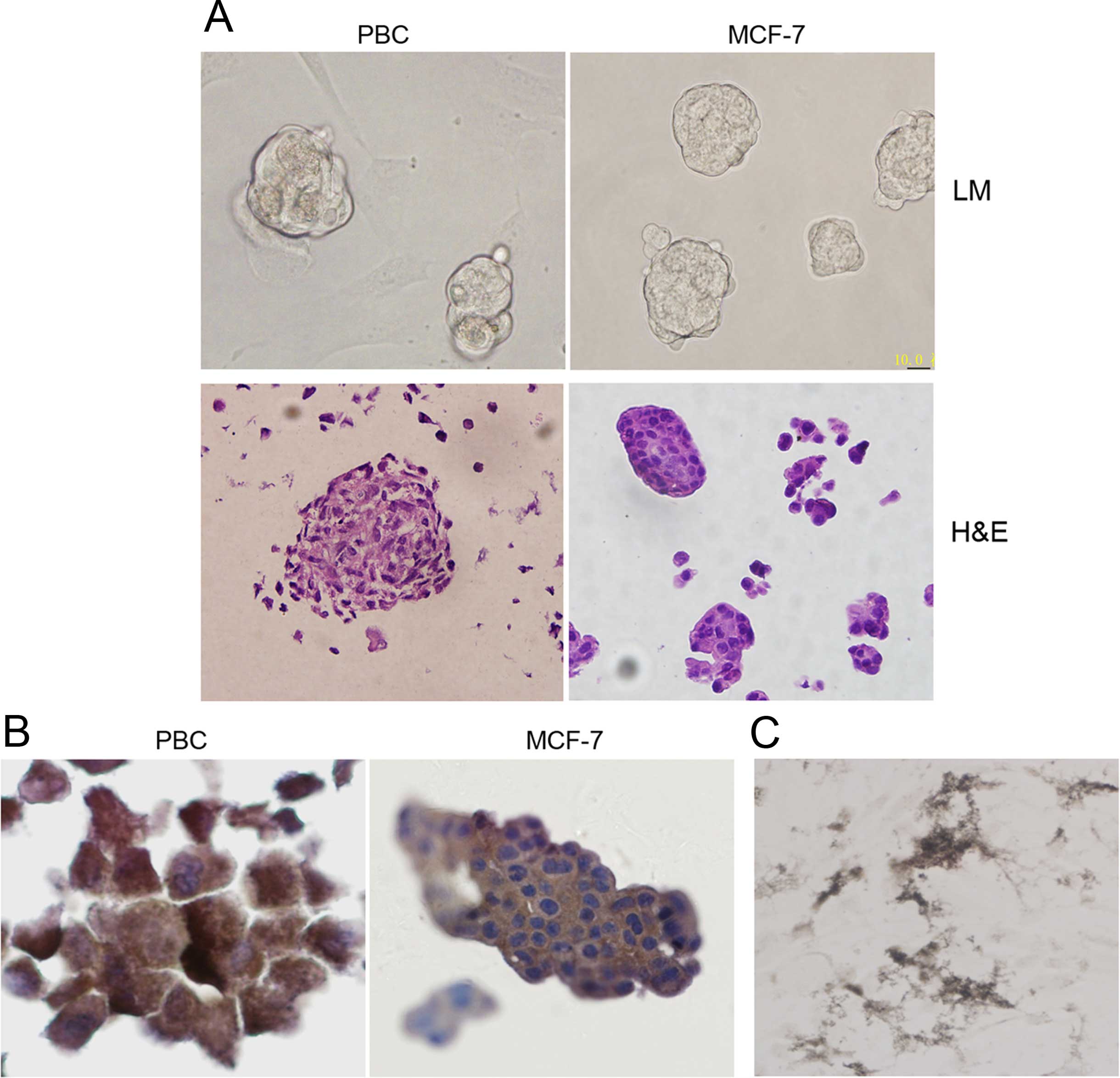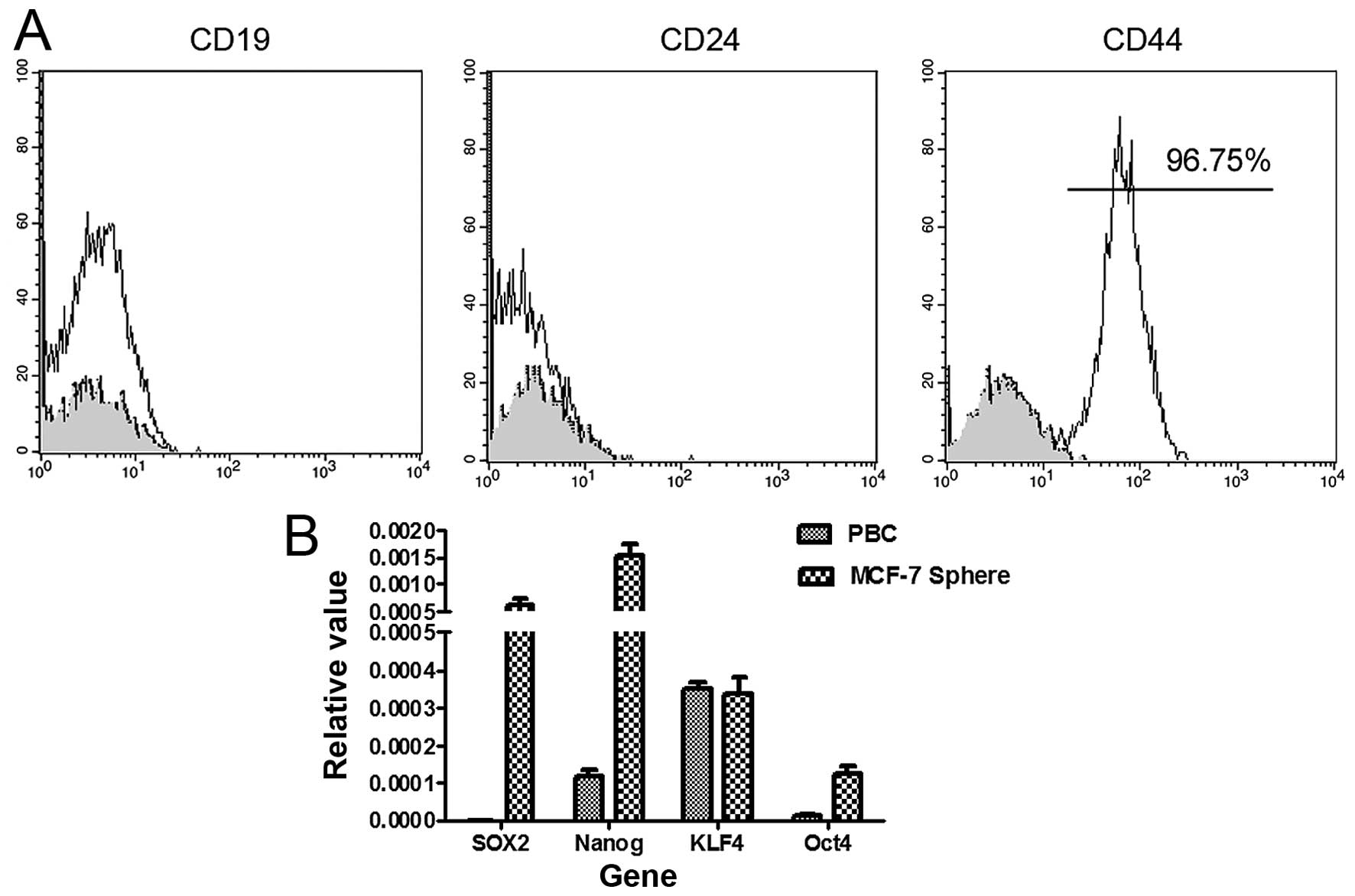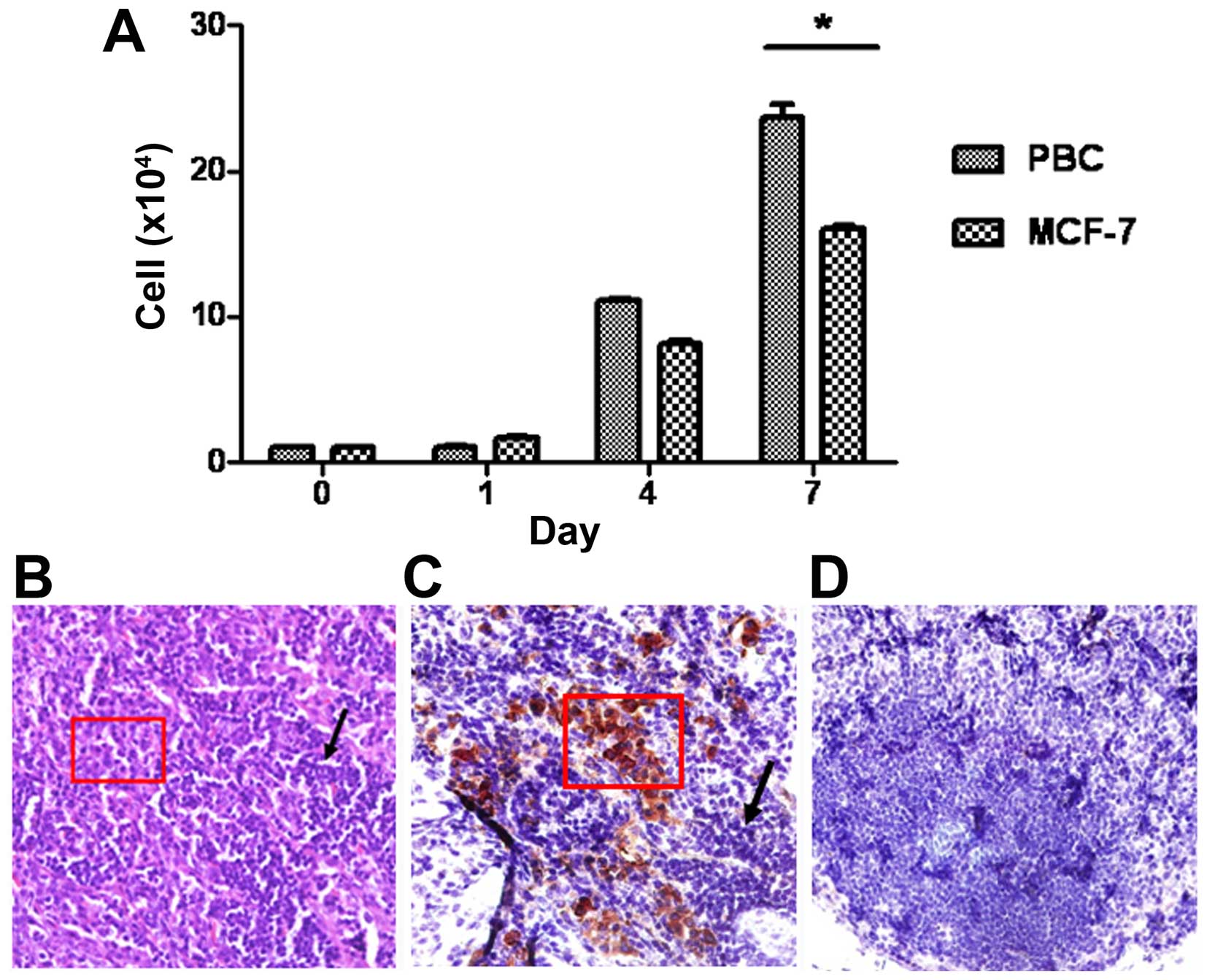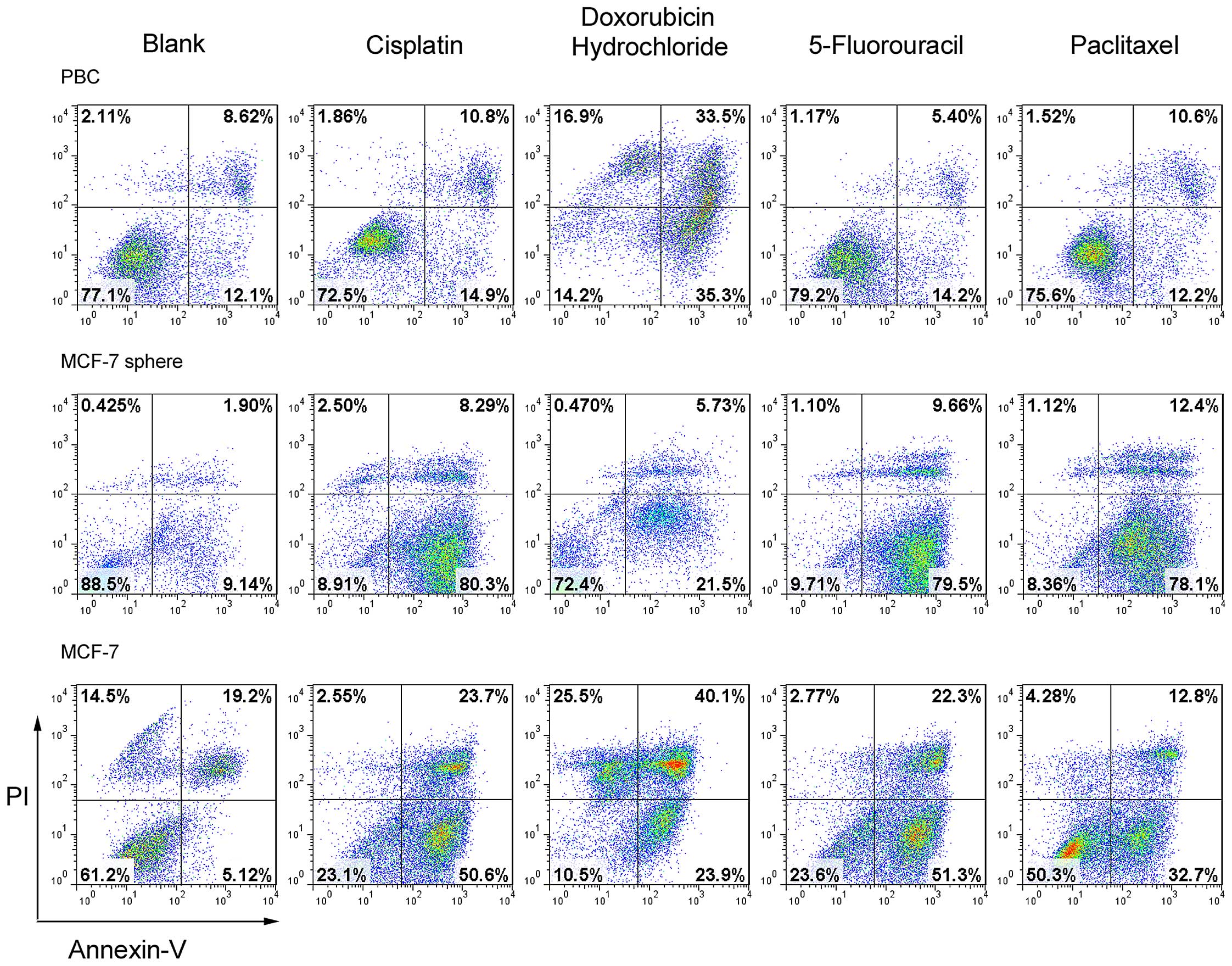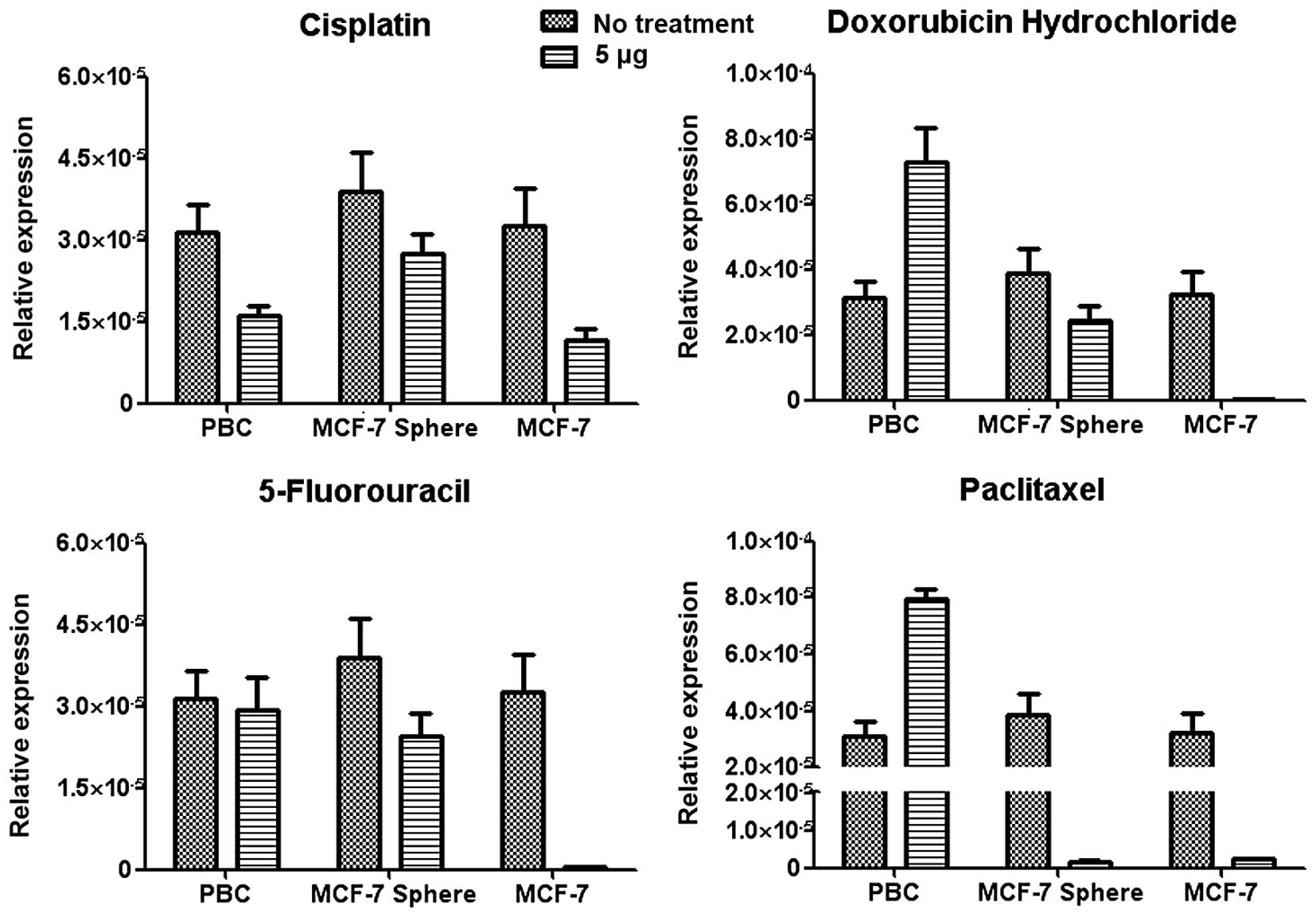|
1
|
World Health Organization: Breast Cancer:
Prevention and Control. http://www.who.int/cancer/detection/breast-cancer/en/index.html.
2013
|
|
2
|
Huang ZZ, Chen WQ, Wu CX, Zheng RS, Chen
JG, Yang NN, Wang N, Zhang SW and Zheng Y: Incidence and mortality
of female breast cancer in China - a report from 32 Chinese cancer
registries, 2003–2007. Tumor. 32:435–439. 2012.
|
|
3
|
Visvader JE and Lindeman GJ: Cancer stem
cells in solid tumours: accumulating evidence and unresolved
questions. Nat Rev Cancer. 8:755–768. 2008. View Article : Google Scholar : PubMed/NCBI
|
|
4
|
Polyak K and Hahn WC: Roots and stems:
stem cells in cancer. Nat Med. 12:296–300. 2006. View Article : Google Scholar : PubMed/NCBI
|
|
5
|
Dalerba P, Cho RW and Clarke MF: Cancer
stem cells: models and concepts. Annu Rev Med. 58:267–284. 2007.
View Article : Google Scholar
|
|
6
|
Ginestier C, Liu S, Diebel ME, Korkaya H,
Luo M, Brown M, Wicinski J, Cabaud O, Charafe-Jauffret E, Birnbaum
D, et al: CXCR1 blockade selectively targets human breast cancer
stem cells in vitro and in xenografts. J Clin Invest. 120:485–497.
2010. View
Article : Google Scholar : PubMed/NCBI
|
|
7
|
Sarry JE, Murphy K, Perry R, Sanchez PV,
Secreto A, Keefer C, Swider CR, Strzelecki AC, Cavelier C, Récher
C, et al: Human acute myelogenous leukemia stem cells are rare and
heterogeneous when assayed in NOD/SCID/IL2Rγc-deficient mice. J
Clin Invest. 121:384–395. 2011. View
Article : Google Scholar :
|
|
8
|
Al-Hajj M, Wicha MS, Benito-Hernandez A,
Morrison SJ and Clarke MF: Prospective identification of
tumorigenic breast cancer cells. Proc Natl Acad Sci USA.
100:3983–3988. 2003. View Article : Google Scholar : PubMed/NCBI
|
|
9
|
Ponti D, Costa A, Zaffaroni N, Pratesi G,
Petrangolini G, Coradini D, Pilotti S, Pierotti MA and Daidone MG:
Isolation and in vitro propagation of tumorigenic breast cancer
cells with stem/progenitor cell properties. Cancer Res.
65:5506–5511. 2005. View Article : Google Scholar : PubMed/NCBI
|
|
10
|
Idowu MO, Kmieciak M, Dumur C, Burton RS,
Grimes MM, Powers CN and Manjili MH:
CD44+/CD24−/low cancer stem/progenitor cells
are more abundant in triple-negative invasive breast carcinoma
phenotype and are associated with poor outcome. Hum Pathol.
43:364–373. 2012. View Article : Google Scholar
|
|
11
|
Bauerschmitz GJ, Ranki T, Kangasniemi L,
Ribacka C, Eriksson M, Porten M, Herrmann I, Ristimäki A, Virkkunen
P, Tarkkanen M, et al: Tissue-specific promoters active in
CD44+CD24−/low breast cancer cells. Cancer
Res. 68:5533–5539. 2008. View Article : Google Scholar : PubMed/NCBI
|
|
12
|
Hwang-Verslues WW, Kuo WH, Chang PH, Pan
CC, Wang HH, Tsai ST, Jeng YM, Shew JY, Kung JT, Chen CH, et al:
Multiple lineages of human breast cancer stem/progenitor cells
identified by profiling with stem cell markers. PLoS One.
4:e83772009. View Article : Google Scholar : PubMed/NCBI
|
|
13
|
Goodell MA, Brose K, Paradis G, Conner AS
and Mulligan RC: Isolation and functional properties of murine
hematopoietic stem cells that are replicating in vivo. J Exp Med.
183:1797–1806. 1996. View Article : Google Scholar : PubMed/NCBI
|
|
14
|
Tirino V, Desiderio V, Paino F, De Rosa A,
Papaccio F, La Noce M, Laino L, De Francesco F and Papaccio G:
Cancer stem cells in solid tumors: an overview and new approaches
for their isolation and characterization. FASEB J. 27:13–24. 2013.
View Article : Google Scholar
|
|
15
|
Reynolds BA and Weiss S: Clonal and
population analyses demonstrate that an EGF-responsive mammalian
embryonic CNS precursor is a stem cell. Dev Biol. 175:1–13. 1996.
View Article : Google Scholar : PubMed/NCBI
|
|
16
|
Dontu G, Abdallah WM, Foley JM, Jackson
KW, Clarke MF, Kawamura MJ and Wicha MS: In vitro propagation and
transcriptional profiling of human mammary stem/progenitor cells.
Genes Dev. 17:1253–1270. 2003. View Article : Google Scholar : PubMed/NCBI
|
|
17
|
Krause S, Maffini MV, Soto AM and
Sonnenschein C: A novel 3D in vitro culture model to study
stromal-epithelial interactions in the mammary gland. Tissue Eng
Part C Methods. 14:261–271. 2008. View Article : Google Scholar : PubMed/NCBI
|
|
18
|
Phuc PVKT, Dong LV, Kiet TD, Giang TT and
Ngoc PK: Isolation and characterization of breast cancer stem cells
from malignant tumours in Vietnamese women. J Cell Anim Biol.
4:163–169. 2010.
|
|
19
|
Grimshaw MJ, Cooper L, Papazisis K,
Coleman JA, Bohnenkamp HR, Chiapero-Stanke L, Taylor-Papadimitriou
J and Burchell JM: Mammosphere culture of metastatic breast cancer
cells enriches for tumorigenic breast cancer cells. Breast Cancer
Res. 10:R522008. View Article : Google Scholar : PubMed/NCBI
|
|
20
|
Shaw FL, Harrison H, Spence K, Ablett MP,
Simões BM, Farnie G and Clarke RB: A detailed mammosphere assay
protocol for the quantification of breast stem cell activity. J
Mammary Gland Biol Neoplasia. 17:111–117. 2012. View Article : Google Scholar : PubMed/NCBI
|
|
21
|
Dontu G, Al-Hajj M, Abdallah WM, Clarke MF
and Wicha MS: Stem cells in normal breast development and breast
cancer. Cell Prolif. 36(Suppl 1): 59–72. 2003. View Article : Google Scholar : PubMed/NCBI
|
|
22
|
Ralston A and Rossant J: The genetics of
induced pluripotency. Reproduction. 139:35–44. 2010. View Article : Google Scholar
|
|
23
|
Rappa G and Lorico A: Phenotypic
characterization of mammosphere-forming cells from the human MA-11
breast carcinoma cell line. Exp Cell Res. 316:1576–1586. 2010.
View Article : Google Scholar : PubMed/NCBI
|
|
24
|
Holliday DL and Speirs V: Choosing the
right cell line for breast cancer research. Breast Cancer Res.
13:2152011. View Article : Google Scholar : PubMed/NCBI
|
|
25
|
Yu F, Yao H, Zhu P, Zhang X, Pan Q, Gong
C, Huang Y, Hu X, Su F, Lieberman J, et al: let-7 regulates self
renewal and tumorigenicity of breast cancer cells. Cell.
131:1109–1123. 2007. View Article : Google Scholar : PubMed/NCBI
|
|
26
|
Singh JK, Farnie G, Bundred NJ, Simões BM,
Shergill A, Landberg G, Howell SJ and Clarke RB: Targeting CXCR1/2
significantly reduces breast cancer stem cell activity and
increases the efficacy of inhibiting HER2 via HER2-dependent
and-independent mechanisms. Clin Cancer Res. 19:643–656. 2013.
View Article : Google Scholar
|
|
27
|
Yu Z, Ji P, Cao J, Zhu S, Li Y, Zheng L,
Chen X and Feng L: Dazl promotes germ cell differentiation from
embryonic stem cells. J Mol Cell Biol. 1:93–103. 2009. View Article : Google Scholar : PubMed/NCBI
|
|
28
|
Raghu HM, Nandi S and Reddy SM: Effect of
insulin, transferrin and selenium and epidermal growth factor on
development of buffalo oocytes to the blastocyst stage in vitro in
serum-free, semidefined media. Vet Rec. 151:260–265. 2002.
View Article : Google Scholar : PubMed/NCBI
|
|
29
|
Sakaguchi M, Dominko T, Yamauchi N,
Leibfried-Rutledge ML, Nagai T and First NL: Possible mechanism for
acceleration of meiotic progression of bovine follicular oocytes by
growth factors in vitro. Reproduction. 123:135–142. 2002.
View Article : Google Scholar : PubMed/NCBI
|
|
30
|
Wang L, Cao J, Ji P, Zhang D, Ma L, Dym M,
Yu Z and Feng L: Oocyte-like cells induced from mouse
spermatogonial stem cells. Cell Biosci. 2:272012. View Article : Google Scholar : PubMed/NCBI
|
|
31
|
Liu S, Dontu G, Mantle ID, Patel S, Ahn
NS, Jackson KW, Suri P and Wicha MS: Hedgehog signaling and Bmi-1
regulate self-renewal of normal and malignant human mammary stem
cells. Cancer Res. 66:6063–6071. 2006. View Article : Google Scholar : PubMed/NCBI
|
|
32
|
Fang D, Nguyen TK, Leishear K, Finko R,
Kulp AN, Hotz S, Van Belle PA, Xu X, Elder DE and Herlyn M: A
tumorigenic subpopulation with stem cell properties in melanomas.
Cancer Res. 65:9328–9337. 2005. View Article : Google Scholar : PubMed/NCBI
|
|
33
|
Adhikari AS, Agarwal N, Wood BM, Porretta
C, Ruiz B, Pochampally RR and Iwakuma T: CD117 and Stro-1 identify
osteosarcoma tumor-initiating cells associated with metastasis and
drug resistance. Cancer Res. 70:4602–4612. 2010. View Article : Google Scholar : PubMed/NCBI
|
|
34
|
Tirino V, Desiderio V, d'Aquino R, De
Francesco F, Pirozzi G, Graziano A, Galderisi U, Cavaliere C, De
Rosa A, Papaccio G, et al: Detection and characterization of
CD133+ cancer stem cells in human solid tumours. PLoS
One. 3:e34692008. View Article : Google Scholar
|
|
35
|
Tirino V, Desiderio V, Paino F, De Rosa A,
Papaccio F, Fazioli F, Pirozzi G and Papaccio G: Human primary bone
sarcomas contain CD133+ cancer stem cells displaying
high tumorigenicity in vivo. FASEB J. 25:2022–2030. 2011.
View Article : Google Scholar : PubMed/NCBI
|
|
36
|
Tirino V, Camerlingo R, Franco R, Malanga
D, La Rocca A, Viglietto G, Rocco G and Pirozzi G: The role of
CD133 in the identification and characterisation of
tumour-initiating cells in non-small-cell lung cancer. Eur J
Cardiothorac Surg. 36:446–453. 2009. View Article : Google Scholar : PubMed/NCBI
|
|
37
|
Ginestier C, Hur MH, Charafe-Jauffret E,
Monville F, Dutcher J, Brown M, Jacquemier J, Viens P, Kleer CG,
Liu S, et al: ALDH1 is a marker of normal and malignant human
mammary stem cells and a predictor of poor clinical outcome. Cell
Stem Cell. 1:555–567. 2007. View Article : Google Scholar
|
|
38
|
Ohi Y, Umekita Y, Yoshioka T, Souda M, Rai
Y, Sagara Y, Sagara Y, Sagara Y and Tanimoto A: Aldehyde
dehydrogenase 1 expression predicts poor prognosis in
triple-negative breast cancer. Histopathology. 59:776–780. 2011.
View Article : Google Scholar : PubMed/NCBI
|
|
39
|
Jung M, Peterson H, Chavez L, Kahlem P,
Lehrach H, Vilo J and Adjaye J: A data integration approach to
mapping OCT4 gene regulatory networks operative in embryonic stem
cells and embryonal carcinoma cells. PLoS One. 5:e107092010.
View Article : Google Scholar : PubMed/NCBI
|
|
40
|
Lengerke C, Fehm T, Kurth R, Neubauer H,
Scheble V, Müller F, Schneider F, Petersen K, Wallwiener D, Kanz L,
et al: Expression of the embryonic stem cell marker SOX2 in
early-stage breast carcinoma. BMC Cancer. 11:422011. View Article : Google Scholar : PubMed/NCBI
|
|
41
|
Zhang P, Andrianakos R, Yang Y, Liu C and
Lu W: Kruppel-like factor 4 (Klf4) prevents embryonic stem (ES)
cell differentiation by regulating Nanog gene expression. J Biol
Chem. 285:9180–9189. 2010. View Article : Google Scholar : PubMed/NCBI
|
|
42
|
Chiou SH, Wang ML, Chou YT, Chen CJ, Hong
CF, Hsieh WJ, Chang HT, Chen YS, Lin TW, Hsu HS, et al:
Coexpression of Oct4 and Nanog enhances malignancy in lung
adenocarcinoma by inducing cancer stem cell-like properties and
epithelial-mesenchymal transdifferentiation. Cancer Res.
70:10433–10444. 2010. View Article : Google Scholar : PubMed/NCBI
|
|
43
|
Boyer LA, Lee TI, Cole MF, Johnstone SE,
Levine SS, Zucker JP, Guenther MG, Kumar RM, Murray HL, Jenner RG,
et al: Core transcriptional regulatory circuitry in human embryonic
stem cells. Cell. 122:947–956. 2005. View Article : Google Scholar : PubMed/NCBI
|
|
44
|
Adachi K and Schöler HR: Directing
reprogramming to pluripotency by transcription factors. Curr Opin
Genet Dev. 22:416–422. 2012. View Article : Google Scholar : PubMed/NCBI
|
|
45
|
Chan KK-K, Zhang J, Chia N-Y, Chan Y-S,
Sim HS, Tan KS, Oh SK, Ng HH and Choo AB: KLF4 and PBX1 directly
regulate NANOG expression in human embryonic stem cells. Stem
Cells. 27:2114–2125. 2009. View Article : Google Scholar : PubMed/NCBI
|
|
46
|
Wei Z, Yang Y, Zhang P, Andrianakos R,
Hasegawa K, Lyu J, Chen X, Bai G, Liu C, Pera M, et al: Klf4
interacts directly with Oct4 and Sox2 to promote reprogramming.
Stem Cells. 27:2969–2978. 2009.PubMed/NCBI
|
|
47
|
Bae KM, Su Z, Frye C, McClellan S, Allan
RW, Andrejewski JT, Kelley V, Jorgensen M, Steindler DA, Vieweg J,
et al: Expression of pluripotent stem cell reprogramming factors by
prostate tumor initiating cells. J Urol. 183:2045–2053. 2010.
View Article : Google Scholar : PubMed/NCBI
|
|
48
|
Lin CW, Liao MY, Lin WW, Wang YP, Lu TY
and Wu HC: Epithelial cell adhesion molecule regulates tumor
initiation and tumorigenesis via activating reprogramming factors
and epithelial-mesenchymal transition gene expression in colon
cancer. J Biol Chem. 287:39449–39459. 2012. View Article : Google Scholar : PubMed/NCBI
|
|
49
|
Sanchez-Carbayo M, Socci ND, Lozano J,
Saint F and Cordon-Cardo C: Defining molecular profiles of poor
outcome in patients with invasive bladder cancer using
oligonucleotide microarrays. J Clin Oncol. 24:778–789. 2006.
View Article : Google Scholar : PubMed/NCBI
|
|
50
|
Creighton CJ, Li X, Landis M, Dixon JM,
Neumeister VM, Sjolund A, Rimm DL, Wong H, Rodriguez A,
Herschkowitz JI, et al: Residual breast cancers after conventional
therapy display mesenchymal as well as tumor-initiating features.
Proc Natl Acad Sci USA. 106:13820–13825. 2009. View Article : Google Scholar : PubMed/NCBI
|
|
51
|
Diehn M, Cho RW, Lobo NA, Kalisky T, Dorie
MJ, Kulp AN, Qian D, Lam JS, Ailles LE, Wong M, et al: Association
of reactive oxygen species levels and radioresistance in cancer
stem cells. Nature. 458:780–783. 2009. View Article : Google Scholar : PubMed/NCBI
|
|
52
|
Donnenberg VS, Meyer EM and Donnenberg AD:
Measurement of multiple drug resistance transporter activity in
putative cancer stem/progenitor cells. Methods Mol Biol.
568:261–279. 2009. View Article : Google Scholar : PubMed/NCBI
|
|
53
|
Chen CJ, Chin JE, Ueda K, Clark DP, Pastan
I, Gottesman MM and Roninson IB: Internal duplication and homology
with bacterial transport proteins in the mdr1 (P-glycoprotein) gene
from multidrug-resistant human cells. Cell. 47:381–389. 1986.
View Article : Google Scholar : PubMed/NCBI
|
|
54
|
Huang M-z, Zhang F-c and Zhang Y-y:
Influence factors on the formation of mammospheres from breast
cancer stem cells. Beijing Da Xue Xue Bao. 40:500–504. 2008.In
Chinese. PubMed/NCBI
|















